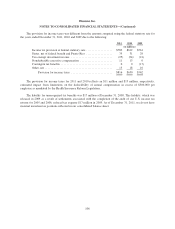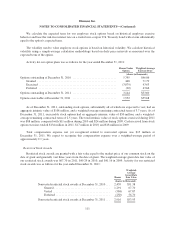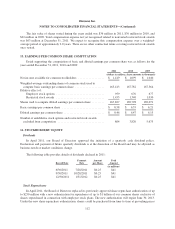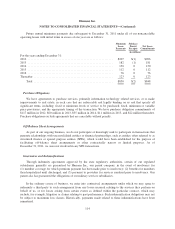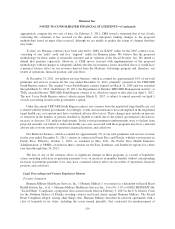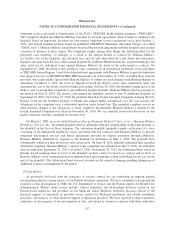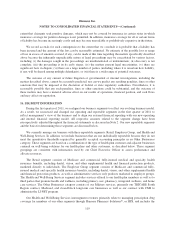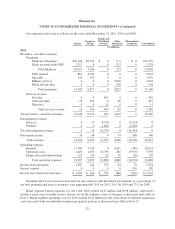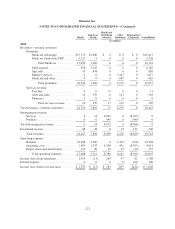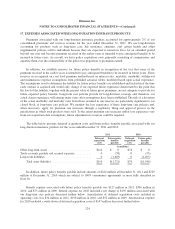Humana 2011 Annual Report Download - page 125
Download and view the complete annual report
Please find page 125 of the 2011 Humana annual report below. You can navigate through the pages in the report by either clicking on the pages listed below, or by using the keyword search tool below to find specific information within the annual report.Humana Inc.
NOTES TO CONSOLIDATED FINANCIAL STATEMENTS—(Continued)
Government Contracts
Our Medicare products, which accounted for approximately 65% of our total premiums and services
revenue for the year ended December 31, 2011, primarily consisted of products covered under the Medicare
Advantage and Medicare Part D Prescription Drug Plan contracts with the federal government. These contracts
are renewed generally for a calendar year term unless CMS notifies us of its decision not to renew by August 1 of
the calendar year in which the contract would end, or we notify CMS of our decision not to renew by the first
Monday in June of the calendar year in which the contract would end. All material contracts between Humana
and CMS relating to our Medicare products have been renewed for 2012, and all of our product offerings filed
with CMS for 2012 have been approved.
CMS uses a risk-adjustment model which apportions premiums paid to Medicare Advantage plans
according to health severity. The risk-adjustment model pays more for enrollees with predictably higher costs.
Under this model, rates paid to Medicare Advantage plans are based on actuarially determined bids, which
include a process that bases our prospective payments on a comparison of our beneficiaries’ risk scores, derived
from medical diagnoses, to those enrolled in the government’s original Medicare program. Under the risk-
adjustment methodology, all Medicare Advantage plans must collect and submit the necessary diagnosis code
information from hospital inpatient, hospital outpatient, and physician providers to CMS within prescribed
deadlines. The CMS risk-adjustment model uses this diagnosis data to calculate the risk-adjusted premium
payment to Medicare Advantage plans. We generally rely on providers to code their claim submissions with
appropriate diagnoses, which we send to CMS as the basis for our payment received from CMS under the
actuarial risk-adjustment model. We also rely on providers to appropriately document all medical data, including
the diagnosis data submitted with claims.
CMS is continuing to perform audits of various companies’ selected Medicare Advantage contracts related
to this risk adjustment diagnosis data. These audits are referred to herein as Risk-Adjustment Data Validation
Audits, or RADV audits. RADV audits review medical record documentation in an attempt to validate provider
coding practices and the presence of risk adjustment conditions which influence the calculation of premium
payments to Medicare Advantage plans.
On December 21, 2010, CMS posted a description of the agency’s proposed RADV sampling and payment
adjustment calculation methodology to its website, and invited public comment, noting that CMS may revise its
sampling and payment error calculation methodology based upon the comments received. We believe the audit
and payment adjustment methodology proposed by CMS is fundamentally flawed and actuarially unsound. In
essence, in making the comparison referred to above, CMS relies on two interdependent sets of data to set
payment rates for Medicare Advantage (MA) plans: (1) fee for service (FFS) data from the government’s original
Medicare program; and (2) MA data. The proposed methodology would review medical records for only one set
of data (MA data), while not performing the same exercise on the other set (FFS data). However, because these
two sets of data are inextricably linked, we believe CMS must audit and validate both of them before determining
the financial implications of any potential RADV audit results, in order to ensure that any resulting payment
adjustment is accurate. We believe that the Social Security Act, under which the payment model was established,
requires the consistent use of these data sets in determining risk-adjusted payments to MA plans. Furthermore,
our payment received from CMS, as well as benefits offered and premiums charged to members, is based on bids
that did not, by CMS design, include any assumption of retroactive audit payment adjustments. We believe that
applying a retroactive audit adjustment after CMS acceptance of bids would improperly alter this process of
establishing member benefits and premiums.
CMS has received public comments, including our comments and comments from other industry
participants and the American Academy of Actuaries, which expressed concerns about the failure to
115



